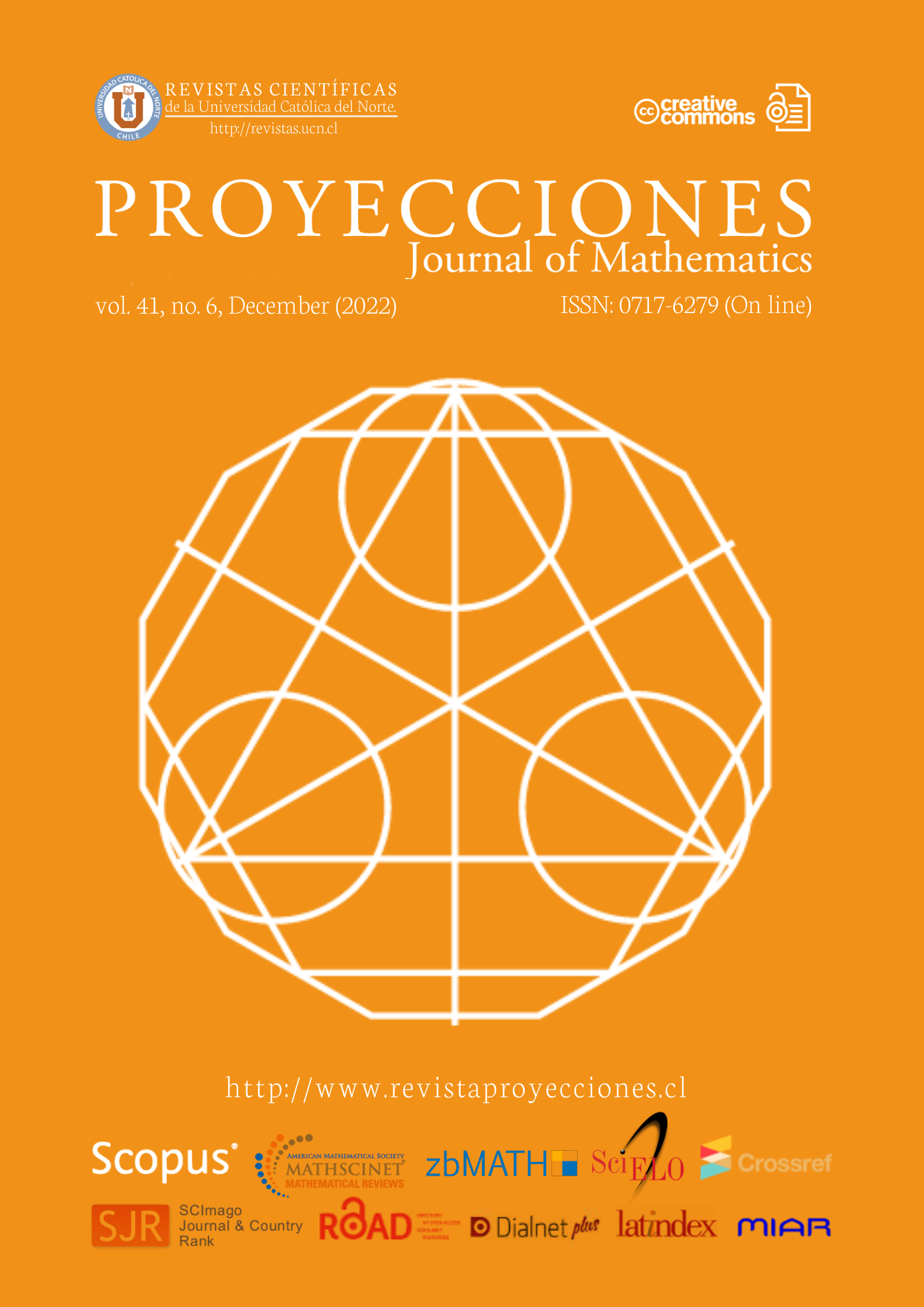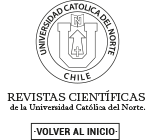Fuzzy sequential topology
DOI:
https://doi.org/10.22199/issn.0717-6279-5330Keywords:
fuzzy sets, fuzzy points, fuzzy neighborhoods, fuzzy continuity, separated, fuzzy sequential closure, fuzzy sequential interior, sequentially fuzzy closed, sequentially fuzzy openAbstract
We define the sequential fuzzy closure and sequential fuzzy interior of fuzzy subsets of $ I^{X} $ by convergence of sequences of fuzzy points. We characterize the fuzzy sequential topology with the sequential fuzzy closure. Furthermore, we compare this topology with the usual fuzzy topology, and prove some basic properties of these concepts.
References
K. K. Azad, “On fuzzy semicontinuity, fuzzy almost continuity and fuzzy weakly continuity”, Journal of Mathematical Analysis and Applications, vol. 82, pp. 14-32, 1981. https://doi.org/10.1016/0022-247x(81)90222-5
C. L. Chang, “Fuzzy topological spaces”, Journal of Mathematical Analysis and Applications, vol. 24, pp. 182-190, 1968. https://doi.org/10.1016/0022-247X(68)90057-7
N. Das and P. Das, “Fuzzy topology generated by fuzzy norm”, Fuzzy Sets and systems, vol. 107, pp. 349-354, 1999. https://doi.org/10.1016/S0165-0114(97)00302-3
M. A. De Prada Vicente and M. Macho Stadler, “t-prefilter theory”, Fuzzy Sets and Systems, vol. 38, pp. 115-124, 1990. https://doi.org/10.1016/0165-0114(90)90104-E
M. A. De Prada Vicente and M. Saralegui Aranguren, “Fuzzy filters”, Journal of Mathematical Analysis and Applications, vol. 129, pp. 560-568, 1988. https://doi.org/10.1016/0022-247X(88)90271-5
D. Dubois, H. M. Prade, and W. Ostasiewicz, Fundamentals of fuzzy sets, vol. 7. Boston: Kluwer Academic, 2000.
P. Eklund and W. Gähler, Fuzzy filter functors and convergence, in Applications of category theory to fuzzy subsets, S. E. Rodabaugh, E.P. Klement, and U. Höhle, Eds. Dordrecht: Springer, 1992, pp. 109-136. https://doi.org/10.1007/978-94-011-2616-8_5
A. El Amrani, A. Razouki, R. A. Hassani, and M. Babahmed, “On the K-vector sequential topology on a non-archimedean valued field”, p-Adic Numbers, Ultrametric Analysis and Applications, vol. 12, pp. 177-184, 2020. https://doi.org/10.1134/s2070046620030012
R. Lowen, “Fuzzy topological spaces and fuzzy compactness”, Journal of Mathematical Analysis and Applications, vol. 56, pp. 621-633, 1976. https://doi.org/10.1016/0022-247X(76)90029-9
A. Esi and M. Acikgoz, “On almost λ-statistical convergence of fuzzy numbers”, Acta Scientiarum. Technology, vol. 36, pp. 129-133, 2014. [On line]. Available: https://bit.ly/3DZYU0p
D. H. Foster, “Fuzzy topological groups”, Journal of Mathematical Analysis and Applications, vol. 67, pp. 549-564, 1979. https://doi.org/10.1016/0022-247X(79)90043-X
W. Gähler, “The general fuzzy filter approach to fuzzy topology II”, Fuzzy Sets and Systems, vol. 76, no. 2, pp. 225-246, 1995. https://doi.org/10.1016/0165-0114(95)00057-R
W. Gähler, “The general fuzzy filter approach to fuzzy topology I”, Fuzzy Sets and Systems, vol. 76, no. 2, pp. 205-224, 1995. https://doi.org/10.1016/0165-0114(95)00058-S
T. E. Gantner, R. C. Steinlage, and R. H. Warren, “Compactness in fuzzy topological spaces”, Journal of Mathematical Analysis and Applications, vol. 62, pp. 547-562, 1978. https://doi.org/10.1016/0022-247X(78)90148-8
J. A. Goguen, “L-fuzzy sets”, Journal of Mathematical Analysis and Applications, vol. 18, pp. 145-174, 1967. https://doi.org/10.1016/0022-247X(67)90189-8
C. M. Hu, “Theory of convergence in fuzzy topological spaces”, The Journal of fuzzy mathematics, vol. 1, pp. 1-12, 1993.
B. Hutton, “Normality in fuzzy topological spaces”, Journal of Mathematical Analysis and Applications, vol. 50, pp. 74-79, 1975. https://doi.org/10.1016/0022-247X(75)90039-6
B. Hutton and I. Reilly, “Separation axioms in fuzzy topological spaces”, Fuzzy Sets and Systems, vol. 3, pp. 93-104, 1980. https://doi.org/10.1016/0165-0114(80)90007-X
A. Katsaras and D. B. Liu, “Fuzzy vector spaces and fuzzy topological vector spaces”, Journal of Mathematical Analysis and Applications, vol. 58, no. 1, pp. 135-146, 1977. https://doi.org/10.1016/0022-247X(77)90233-5
A. K. Katsaras, “Fuzzy proximity spaces”, Journal of Mathematical Analysis and Applications, vol. 68, pp. 100-110, 1979. https://doi.org/10.1016/0022-247X(79)90102-1
L. D. R. Kočinac, ”Selection properties in fuzzy metric spaces”, Filomat, vol. 26, no. 2, pp. 305-312, 2012. https://doi.org/10.2298/FIL1202305K
L. D. R. Kočinac and M. H. M. Rashid, ”On ideal convergence of double sequences in the topology induced by a fuzzy 2-norm”, TWMS Journal of Applied and Engineering Mathematics, vol. 8, pp. 97-111, 2017. [On line]. Available: https://bit.ly/3DV4alF
S. Krishna and K. Sarma, “Separation of fuzzy normed linear spaces”, Fuzzy sets and systems, vol. 63, no. 2, pp. 207-217, 1994. https://doi.org/10.1016/0165-0114(94)90351-4
B. Y. Lee, J. H. Park, and B. H. Park, “Fuzzy convergence structures”, Fuzzy Sets and Systems, vol. 56, no. 3, pp. 309-315, 1993. https://doi.org/10.1016/0165-0114(93)90211-Y
R. Lowen, “Topologies floues", C. R. Acad. Sci. Paris Sér. A, vol. 278, pp. 925-928, 1974.
R. Lowen, “Convergence in fuzzy topological spaces”, General Topology and its Applications, vol. 10, pp. 147-160, 1979. https://doi.org/10.1016/0016-660X(79)90004-7
R. Lowen, “The relation between filter and net convergence in fuzzy topological spaces”, Fuzzy mathematics, vol. 3, pp. 41-52, 1983.
R. Lowen, Fuzzy set theory. Dordrecht: Kluwer Academic Publishers, 1996.
M. Macho Stadler and M. A. De Prada Vicente, “Fuzzy t-net theory”, Fuzzy Sets and Systems, vol. 37, no. 2, pp. 225-235, 1990. https://doi.org/10.1016/0165-0114(90)90045-8
P. Mikusiński, “Axiomatic theory of convergence”, Uniwersytet Śląski w Katowicach Prace Nauk.-Prace Mat., pp. 13-21, 1982.
P. M. Pu and Y. M. Liu, “Fuzzy topology. I. Neighborhood structure of a fuzzy point and Moore-Smith convergence”, Journal of Mathematical Analysis and Applications, vol. 76, pp. 571-599, 1980. https://doi.org/10.1016/0022-247X(80)90048-7
M. H. M. Rashid and L. D. R. Kočinac, “Ideal convergence in 2-fuzzy 2-normed spaces”, Hacettepe Journal of Mathematics and Statistics, vol. 1, no. 46, pp. 149-162, 2017. [On line]. Available: https://bit.ly/3tpTjeB
A. Rosenfeld, “Fuzzy groups”, Journal of Mathematical Analysis and Applications, vol. 35, no. 3, pp. 512-517, 1971. https://doi.org/10.1016/0022-247X(71)90199-5
S. Saha, “Fuzzy δ-continuous mappings”, Journal of Mathematical Analysis and Applications, vol. 126, no. 1, pp. 130-142, 1987. https://doi.org/10.1016/0022-247X(87)90081-3
M. Saralegi and M. A. de Prada Vicente, Una nota sobre convergencia en espacios topologicos fuzzy, pp. 763-766, 1982. [On line]. Available: https://bit.ly/3A58luc
M. Sarkar, “On fuzzy topological spaces”, Journal of Mathematical Analysis and Applications, vol. 79, no. 2, pp. 384-394, 1981. https://doi.org/10.1016/0022-247X(81)90033-0
R. Srivastava, S. Lal, and A. K. Srivastava, “Fuzzy hausdorff topological spaces”, Journal of mathematical analysis and applications, vol. 81, no. 2, pp. 497-506, 1981. https://doi.org/10.1016/0022-247X(81)90078-0
M. M. Stadler and M. de Prada Vicente, “On n-convergence of fuzzy nets”, Fuzzy sets and Systems, vol. 51, no. 2, pp. 203-217, 1992. https://doi.org/10.1016/0165-0114(92)90193-8
B. Tripathy and S. Borgohain, “The sequence space m(φ, δm, p)F “, Fasciculi Mathematici, pp. 87-96, 2008. [On line]. Available: https://bit.ly/3WRUkd1
B. C. Tripathy and S. Borgohain, “Some classes of difference sequence spaces of fuzzy real numbers defined by orlicz function”, Advances in Fuzzy systems, vol. 2011, no. 6, 2011. https://doi.org/10.1155/2011/216414
B. C. Tripathy and S. Borgohain, “Statistically convergent difference sequence spaces of fuzzy real numbers defined by orlicz function”, Thai Journal of Mathematics, vol. 11, no. 2, pp. 357-370, 2012. [On line]. Available: https://bit.ly/3ElFAvG
B. C. Tripathy and S. Borgohain, “On a class of n-normed sequences related to cp-space”, Boletim da Sociedade Paranaense de Matemática, vol. 31, pp. 167-173, 2013. https://doi.org/10.5269/bspm.v31i1.15414
B. C. Tripathy and G. C. Ray, “Weakly continuous functions on mixed fuzzy topological spaces”, Acta Scientiarum. Technology, vol. 36, pp. 331-335, 2014. https://doi.org/10.4025/actascitechnol.v36i2.16241
B. C. Tripathy and G. C. Ray, “Fuzzy δ-I-continuity in mixed fuzzy ideal topological spaces”, Journal of Applied Analysis, vol. 24, no. 2, pp. 233-239, 2018. https://doi.org/10.1515/jaa-2018-0022
B. C. Tripathy and G. C. Ray, “Fuzzy δ-almost continuous and fuzzy δ-continuous functions in mixed fuzzy ideal topological spaces”, Proyecciones (Antofagasta), vol. 39, no. 2, pp. 435-449, 2020. https://doi.org/10.22199/issn.0717-6279-2020-02-0027
R. Warren, “Continuity of mapping of fuzzy topological spaces, In Notices of The American Mathematical Society”, American Mathematical Society, vol. 21, pp. A451-A451, 1974.
L. A. Zadeh, “Fuzzy sets”, Information and Control, vol. 8, pp. 338-353, 1965. https://doi.org/10.1016/S0019-9958(65)90241-X
Published
How to Cite
Issue
Section
Copyright (c) 2022 Rachid Ameziane Hassani, Aziz Blali, Abdelhak Razouki, Abdelkhalek El Amrani

This work is licensed under a Creative Commons Attribution 4.0 International License.
-
Attribution — You must give appropriate credit, provide a link to the license, and indicate if changes were made. You may do so in any reasonable manner, but not in any way that suggests the licensor endorses you or your use.
- No additional restrictions — You may not apply legal terms or technological measures that legally restrict others from doing anything the license permits.












